
British hardened field defences of World War II
Encyclopedia
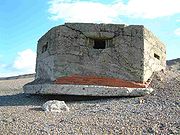
British anti-invasion preparations of World War II
British anti-invasion preparations of the Second World War entailed a large-scale division of military and civilian mobilisation in response to the threat of invasion by German armed forces in 1940 and 1941. The British army needed to recover from the defeat of the British Expeditionary Force in...
. They were popularly known as pillboxes by reference to their shape.
Design and development
In May 1940, the directorate of Fortifications and Works (FW3) was set up at the War Office under the direction of Major-General G. B. O. Taylor. Its purpose was to provide a number of basic pillbox designs which could be constructed by soldiers and local labour at appropriate defensive locations. In the following June and July FW3 issued 6 basic designs for rifle and light machine gun, designated Type 22 to Type 27. In addition, there were designs for gun emplacements suitable for either the Ordnance QF 2 pounderOrdnance QF 2 pounder
The Ordnance QF 2-pounder was a British anti-tank and vehicle-mounted gun, employed in the Second World War. It was actively used in the Battle of France, and during the North Africa campaign...
or the Hotchkiss 6pdr gun (designated Type 28) and a design for a hardened medium machine gun emplacement.
There were also designs for pillbox-like structures for various purposes including light anti-aircraft positions, observation posts and searchlight positions to illuminate the shoreline. In addition, the Air Ministry provided designs of fortifications intended to protect airfields from troops landing or parachuting. These would not be expected to face heavy weapons so that the degree of protection was less and there was more emphasis on all-round visibility and sweeping fields of fire. Many of these were later reinforced.
Embrasure
Embrasure
In military architecture, an embrasure is the opening in a crenellation or battlement between the two raised solid portions or merlons, sometimes called a crenel or crenelle...
s were available precast and factory produced to standard designs, but as these were in short supply some embrasures were improvised from brick or concrete paving. Embrasures were frequently fitted with a steel or concrete-asbestos shutter. From March 1941, some pillbox embrasures were fitted with a Turnbull mount: this was a metal frame that supported a medium machine gun.
The degree of protection offered by a pillbox varied considerably: the thickness of the walls and roof generally varied from just 12 in to 3 ft 6 in (0.3 to 1.1m) or more although the commercially produced designs were often much thinner. In March 1940, General Brooke carried out penetration trials and recorded that a anti-tank gun could easily penetrate up to 2 feet (61 cm) of reinforced concrete. Despite such results the thick-walled pillboxes were designated as shell-proof, whereas the thinner-walled pillboxes were designated as bulletproof.
Internally, pillboxes are generally cramped and spartan. Some internal concrete shelves and tables were provided to support weapons and some were whitewashed inside. Only the Type 28s provided a little space — sufficient for a few home comforts.
Adaptations
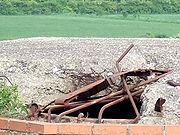
Appearance also varied due to the building materials used, although all the FW3 designs are formed from reinforced concrete. Where brick was used as a shuttering, the bricks essentially formed a mould into which concrete was poured, the bricks being left in place. Otherwise, the pillbox was formed using shuttering of wood (usually planks, but sometimes plywood) and/or corrugated iron. Wood shuttering was removed, whereas corrugated iron was sometimes left in place. Construction often took advantage of whatever materials were available locally (for example, at the coast, beach sand and pebbles would be used) and this expedient use of local materials had the added advantage of aiding camouflage. The reinforced concrete used in construction was generally conventional making use of thin steel rebars with floor, walls and roof all mutually bonded. However, several instances are known where scrap metal had been used such as parts of an old bed or park railings.
Local commanders introduced modifications to the standard FW3 designs or introduced designs of their own which may be produced in some numbers or completely ad hoc designs suited to local conditions. Other designs were produced as commercial ventures. Finally, there were a small number of pillboxes that had been constructed in the first world war.
FW3 pillbox types
The approximate numbers of extant pillboxes of each type are given based on data from the Defence of Britain database.Type 22
The type 22 pillbox is a regular hexagon in plan with an embrasure in five of the sides and an entrance in the other. The embrasures are suitable for rifles or light machine guns. Some have a low entrance that allows an extra embrasure above. Each wall is about 6 feet (1.8 m) long and it was generally built to the bulletproof standard of 12 inches (30 cm) thick, although 'tank-gun proof' versions with walls around 40 inches (1 m) thick were also built (e.g. the granite and concrete examples on the Cowie Line in Kincardineshire). Internally there is a Y- or T- shaped anti-ricochet wall (the top of the Y/T nearest the entrance), the internal wall also helps support the roof.The type 22 is the second most common pillbox type with 1,209 recorded as being extant. It is easily confused with the common type 24 which is an irregular hexagon and the less common octagonal.
Type 23
The type 23 pillbox is rectangular in plan — essentially two squares, one of which is roofed and the other open — with embrasures in each of the available sides of the covered section. The embrasures are suitable for rifles or light machine guns. The open section was for a light anti-aircraft defence: a Bren or Lewis gun on a mounting. Usually, there is no ground level entrance, to get in one had to climb over the wall into the open section and then pass though a door to the covered section. The walls were 8 feet (2.4 m) wide by 16 feet (4.9 m) long and usually built to a bulletproof standard of 12 inches (30 cm) thick.The type 23 is uncommon, 156 are recorded as being extant. A further variant exists in Lincolnshire consisting of a double chambered type 23 with an access door with anti-aircraft gun mount and a chamber on either side
Type 24
The type 24 pillbox is an irregular hexagon in plan. The rear wall is the longest at about 14 feet (4.3 m), this has the entrance with an embrasure on either side. The other walls vary from each having a single embrasure. The embrasures are suitable for rifles or light machine guns. Internally there is a Y shaped anti-ricochet wall (the top of the Y nearest the entrance), the internal wall also helps support the roof. The type 24 was always built to at least bullet-proof standard of 12 inches (30 cm) thick, but often was thicker.A thick walled variant was introduced to a shellproof standard; it was larger externally and had walls , thick. (This thick-walled variant is, confusingly, sometimes called a Type 29 by pillbox researchers, but this is not an official designation and should be avoided.) In a variant on the Scottish Command Line the entrance was moved from the long wall and the two rifle embrasures were increased in size to allow a Bren and Boys Anti-tank rifle to be mounted side by side.
The type 24 is the most common type with more than 1787 recorded as being extant.
Type 25
The type 25 pillbox is the only FW3 design that is circular with a diameter of 8 feet (2.4 m). The walls were just 12 inches (30 cm) thick with no internal walls. There were three embrasures suitable for rifles or light machine guns and a small entrance like a low window. This design was made from reinforced concrete shuttered by corrugated iron; this gave the design the popular name ArmcoAK Steel Holding
AK Steel Corporation is an American steel company whose predecessor, Armco, was founded in 1899 in Middletown, Ohio. Today, the company's corporate headquarters is situated in West Chester, Ohio, after having moved from Middletown, Ohio, in August 2007.- Products :AK Steel's main products are...
after the manufacturer of corrugated iron of that name.
The type 25 is rare, about 46 are recorded as extant.
Type 26
The type 26 is a simple square in plan, each wall being 10 feet (3 m) long. There is a door in one side and embrasures in each of the remaining three walls with, possibly, an additional embrasure next to the door. There are no internal walls. Occasionally, there are two embrasures in one of the walls. The embrasures are suitable for rifles or light machine guns. Walls are normally constructed to bulletproof standard at about 18 inches (46 cm) thick..jpg)
The type 26 is uncommon, 199 are recorded as extant.
Type 27
The type 27 is the most varied of the FW3 designs, it may be an octagonal or hexagonal in plan with walls between 9 ft 9 in and 11 ft 6 in (3.0–3.5 m). The outer walls being 36 inches (91 cm) thick and have embrasures suitable for rifles or light machine guns on each facet. Its defining characteristic is a central well open to the sky that could be used as a light anti-aircraft position.Type 27 is uncommon, 127 are recorded as extant.
Type 28
The type 28 is the largest of the FW3 designs and the only one with a specific anti-tank capability. It is almost square in plan with the forward facing corners chamfered. The walls are about 20 by long constructed to shell-proof specification at about 42 inches (107 cm) thick. There is a very large forward embrasure. It was designed to take an 2 pounder anti-tank gunOrdnance QF 2 pounder
The Ordnance QF 2-pounder was a British anti-tank and vehicle-mounted gun, employed in the Second World War. It was actively used in the Battle of France, and during the North Africa campaign...
or a Hotchkiss 6pdr gun
QF 6 pounder 6 cwt Hotchkiss
The Ordnance QF 6 pounder 6 cwt Hotchkiss Mk 1 and Mk 2 was a shortened version of the original QF 6 pounder Hotchkiss, and was developed specifically for use in the sponsons of the later Marks of British tanks in World War I, from Mark IV onwards.-History:...
. The gun shield of the artillery piece would largely fill the aperture. There are usually embrasures suitable for rifles or light machine guns in each of the two side walls.
Superficially, the type 28 resembles the smaller Vickers MMG emplacement, but the aperture is much larger and there is a very large rear entrance designed for ease of wheeling the gun in and out.
The type 28A is an important and common variant – it is more common than the unmodified type 28. It is wider than the type 28 to allow for a side area for an infantry chamber giving a forward facing embrasure suitable for a rifle or light machine gun. This resolved the problem of the type 28 being vulnerable to a head-on infantry attack.

The traverse of the gun was limited to about 60°. Generally, these pillboxes were positioned to fire along fixed lines, such as enfilading fire
Enfilade and defilade
Enfilade and defilade are concepts in military tactics used to describe a military formation's exposure to enemy fire. A formation or position is "in enfilade" if weapons fire can be directed along its longest axis. A unit or position is "in defilade" if it uses natural or artificial obstacles to...
across an anti-tank ditch or at a bridge and in such positions the limited traverse of the gun creates no real disadvantage; whereas, the small size of the embrasure provides greater protection for the gun and its crew.
The type 28 and its variants are fairly common, there are some 350 or so recorded as extant.
Vickers MMG emplacement
The Vickers machine gunVickers machine gun
Not to be confused with the Vickers light machine gunThe Vickers machine gun or Vickers gun is a name primarily used to refer to the water-cooled .303 inch machine gun produced by Vickers Limited, originally for the British Army...
pillbox is essentially square in plan with the forward facing corners chamfered. The walls are 14 feet (4.3 m) long and there is generally a freestanding blast wall covering the entrance on either the left or right side. The walls were constructed to shellproof standard of 36 inches (91 cm). There are no internal walls. There is a large embrasure and inside is a concrete, trapezoid
Trapezoid
In Euclidean geometry, a convex quadrilateral with one pair of parallel sides is referred to as a trapezoid in American English and as a trapezium in English outside North America. A trapezoid with vertices ABCD is denoted...
al table on which to mount the weapon's tripod. The other walls would each have an embrasure suitable for a rifle or light machine gun.
They are frequently sited in pairs and were often dug-in with overhead earth cover.
Vickers MMG emplacements of this exact type are uncommon, just over 75 are recorded as extant but there are many local variants of this basic type.
Field gun emplacements
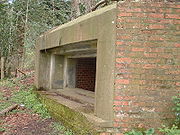
Cantilever pillbox
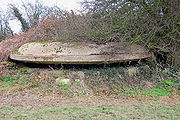
Lozenge pillbox
The lozenge pillbox is found only in the North East of England. Lozenge pillboxes are an irregular hexagon in plan with the front and rear walls significantly longer than the others, this allows space for four forward-facing embrasures. The rear wall has two embrasures and an entrance. The four short walls each have a single embrasure. Internally, an anti-ricochet wall runs longitudinally. It was designed for infantry armed with rifles and/or light machine guns.Eared pillbox
The eared pillbox is, like the lozenge pillbox, found only in the North East of England and has an irregular hexagon plan. There are two large embrasures intended for medium machine guns. There is a bulge at the base of the wall below the embrasures that is thought to have accommodated the cooling system for the machine gun. Internally, there is a short anti-ricochet wall.The two embrasures are at 90° to each other giving an arc of fire of about 180° with no way to direct fire behind the pillbox. This design is frequently found on or near beaches — ideal for providing enfilading fire. There are two entrances with openings in the same direction as the embrasures.
Lincolnshire three-bay
Found only in LincolnshireLincolnshire
Lincolnshire is a county in the east of England. It borders Norfolk to the south east, Cambridgeshire to the south, Rutland to the south west, Leicestershire and Nottinghamshire to the west, South Yorkshire to the north west, and the East Riding of Yorkshire to the north. It also borders...
, this type has become known as a Lincolnshire three-bay pillbox. It is essentially a modification of the FW3 type 23 having an open light anti-aircraft position in the centre and fully enclosed bays at either end.
Dover Quad
The Dover Quad pillbox is a 13 feet (4 m) square pillbox with wide embrasures and an overhanging roof slab. This design is only found in the Dover area of England and are very often found at high commanding positions. Some commentators opine that the Dover Quad is a poor design: the overhanging slab, while offering some protection from strafing, is liable to ricochet bullets from below into the embrasure which is, in any case, wide giving inadequate protection. Given the vulnerability of the port of Dover, it is possible that these were among the first World War II pillboxes constructed and they may have pre-dated the FW3 designs, but there is no evidence for this.Section post / Seagull trench
,_cayton_bay_(interior).jpg)
Somerset defence post
The defence post is only found in Somerset; it is about 8 feet (2.4 m) square with walls about 15 inches (38.1 cm) thick and has wide slits extending the full width of three faces. There is a porch covering the entrance. Some have an open section on top reached by rungs and a ladder.Norcon pillbox
The Norcon was a small circular pillbox named after the company that manufactured it as a private commercial venture. It was made from a concrete pipe 6 feet (1.8 m) in diameter and 4 feet (1.2 m) high; the walls were 4 inches (10 cm) of non-reinforced concrete with several cut loopholes. It was described as being possibly the most dangerous, cheap and nasty of all the pillbox designs. Being quick to manufacture was its biggest asset: it was possible to turn out about 20 a day, the concrete being cured in about 24 hours, but few were actually built. The standard model lacked a roof: others had a roof made of timber and corrugated iron, and earth; extra protection was provided by the use of sandbags.Ruck machine gun post/pillbox
The Ruck machine gun post (or Ruck pillbox)was designed by James Ruck and was made from prefabricated sections, paving slabs, sandbags and rammed earth. The Ruck machine gun post was relatively widely used in Lincolnshire and along the east coast of England, but is now extremely rare with just a handful of extant examples.Five Ruck machine gun post sites are recorded in the Defence of Britain database.
Pickett-Hamilton Fort
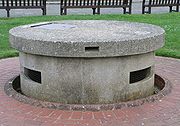
Allan Williams Turret
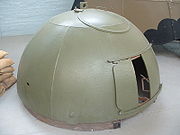
Vickers machine gun
Not to be confused with the Vickers light machine gunThe Vickers machine gun or Vickers gun is a name primarily used to refer to the water-cooled .303 inch machine gun produced by Vickers Limited, originally for the British Army...
, Bren, Hotchkiss
Hotchkiss M1914 machine gun
The Mle 1914 Hotchkiss machine gun became the standard machine gun of the French Army during World War I. It was manufactured by the French arms company Hotchkiss et Cie, which had been established in the 1860s by American industrialist Benjamin B. Hotchkiss...
or Lewis machine guns
Lewis Gun
The Lewis Gun is a World War I–era light machine gun of American design that was perfected and widely used by the British Empire. It was first used in combat in World War I, and continued in service with a number of armed forces through to the end of the Korean War...
in either a ground defence or anti-aircraft role, or a Boys anti-tank rifle or rifle grenade
Rifle grenade
A rifle grenade is a grenade that uses a rifle-based launcher to permit a longer effective range than would be possible if the grenade was thrown by hand...
for ground defence. Weapon change requires selection of appropriate bracket. The army did not favour the design, most were installed at airfields.
The turret was designed by A.H. Williams in conjunction with Colonel V.T.R. Ford and Lieutent Williamson. Williams was the Managing Director of Rustproof Metal Windows Company in Saltney
Saltney
Saltney is a small town in Flintshire, Wales. It is immediately to the west of the border with Cheshire in England and is contiguous with the Chester urban area.The name is derived from the former salt marshes on which it is built, lying on the River Dee...
, Chester
Chester
Chester is a city in Cheshire, England. Lying on the River Dee, close to the border with Wales, it is home to 77,040 inhabitants, and is the largest and most populous settlement of the wider unitary authority area of Cheshire West and Chester, which had a population of 328,100 according to the...
where the turrets were produced. The company had been engaged in war work since 1939, mainly manufacturing ammunition boxes for the Admiralty using a patented galvanising process.
The turret had a garrison of two men or, if necessary three men, for whom there were folding seats inside. One man can rotate the cupola which is on roller bearings and requires 15 lb of force to move it.
According to the manufacturer, four men could dig the position out and erect the turret ready for firing in two hours and remove it completely removed in 30 minutes. Cost about £125.
Nearly 200 Allan Williams Turrets were made and installed, salvaging of the metal after the war means that today very few remain.
Tett Turret
The Tett turret was named after its inventor H.L. Tett and manufactured as a private commercial venture by Burbridge Builders Ltd of SurreySurrey
Surrey is a county in the South East of England and is one of the Home Counties. The county borders Greater London, Kent, East Sussex, West Sussex, Hampshire and Berkshire. The historic county town is Guildford. Surrey County Council sits at Kingston upon Thames, although this has been part of...
. It comprised a revolving concrete turret mounted on a ball race
Rolling-element bearing
A rolling-element bearing, also known as a rolling bearing, is a bearing which carries a load by placing round elements between the two pieces...
that allowed it to be turned easily. The turret was set above a pit; in early designs, the pit was formed by a standard section of concrete pipe
Pipe (material)
A pipe is a tubular section or hollow cylinder, usually but not necessarily of circular cross-section, used mainly to convey substances which can flow — liquids and gases , slurries, powders, masses of small solids...
4 feet (1.2 m) in diameter.
Today, extant examples are very rare.
Spigot mortar emplacement

Blacker Bombard
The Blacker Bombard, also known as the 29mm Spigot Mortar, was an infantry anti-tank weapon devised by Lieutenant-Colonel Stewart Blacker in the early years of the Second World War.-Development:...
— effective against both tanks and personnel — at ranges of about 100 yards (91.4 m) and 500 yards (457.2 m) respectively.
Embrasured walls and buildings
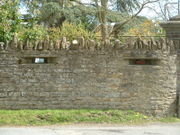
Camouflage
.jpg)
Military camouflage
Military camouflage is one of many means of deceiving an enemy. In practice, it is the application of colour and materials to battledress and military equipment to conceal them from visual observation. The French slang word camouflage came into common English usage during World War I when the...
. Many were dug into the ground or inserted into a hedgerow or hillside to provide the lowest possible profile; others had soil piled up on the roof and sides. Camouflage paint schemes and camouflage netting would be used to help break up the outline. Use was made of local materials: concrete made with beach sand, a covering of beach pebbles, or stone from a nearby cliff was not only a time saving measure but aided camouflage by helping the defences to merge into the background.
Artists such as Roland Penrose
Roland Penrose
Sir Roland Algernon Penrose CBE was an English artist, historian and poet. He was a major promoter and collector of modern art and an associate of the surrealists in the United Kingdom.- Biography :...
(author of the Home Guard Manual of Camouflage), Stanley William Hayter
Stanley William Hayter
Stanley William Hayter , CBE was a British painter and printmaker associated in the 1930s with Surrealism and from 1940 onward with Abstract Expressionism. Regarded as one of the most significant printmakers of the 20th century, in 1927 Hayter founded the legendary Atelier 17 studio in Paris...
, Julian Trevelyan
Julian Trevelyan
Julian Otto Trevelyan, RA was a British artist and poet.Trevelyan was the only child of Robert Calverley Trevelyan and his wife Elizabeth van der Hoeven...
and many others were employed to conceal defences. In built-up areas pillboxes were disguised to look like a part of an adjacent building, carefully matched and provided with a roof to look as if they had always been there. In extreme cases, they were built inside existing buildings.
Some pillboxes were carefully constructed to resemble a quite different, innocent, structure: a haystack, a disused cottage, seaside kiosk, bus-stop shelter or railway signal box. It was not uncommon for pillboxes to be fitted with a dummy pitched roof to aid the deception. Some of these disguises bordered on the fanciful.
In some cases, the reinforced concrete roof was sculpted to make the distinctive form of a pillbox less obvious from the air.
In Somerset, along part of the Taunton stopline due to the shortage of material available, six pillboxes were coated with a mixture of cow manure and mud topped with straw as a form of natural concealment. Close to Axminster a square pillbox was disguised as a Romany caravan. During the summer months a scarecrow "family" and a horse made of straw were dressed and suitably arranged around the caravan to visually deceive that it was actually a manned pillbox.
Destruction, neglect, rediscovery and reuse
.jpg)

After the war, farmers, across whose land structures had been built were, in addition to receiving compensation, paid to fill in ditches and trenches and to demolish pillboxes. Today, hardly anything remains of the anti-tank ditches, but at the time they must have been the most conspicuous of all the fortifications; a few remain, much humbled, as field drains or field boundaries whereas others can be seen only as crop marks. In the case of pillboxes, the sum of £5 is sometimes mentioned to pay for demolition, but the challenge of demolishing such structures is considerable and it seems that most farmers pocketed the cash, treating it as compensation.
Today, it is very rare to find any part of Britain's defences other than that composed of concrete. Immediately after the war, there were more pressing matters to attend to than conserving the detritus of a battle that never happened. For decades, with the sole exception of Pevensey Castle
Pevensey Castle
Pevensey Castle is a medieval castle and former Roman fort at Pevensey in the English county of East Sussex. The site is a Scheduled Monument in the care of English Heritage and is open to visitors.-Roman fort:...
— where the new fortifications were seen as a part of the building's history — there was never even a suggestion that anything should be deliberately conserved.
As the years passed, erosion and modern construction destroyed many structures: at the coast fortifications have tumbled into the sea or sunk into the sands on which they were built; yet other features have succumbed to road improvements or have been demolished to make way for other modern developments. For many of those that remain, neglect and the attentions of nature have achieved a degree of camouflage greater than that of during the Second War.
Years after the war, memories faded and in the public mind it became popular to assume that the few pillboxes and other concrete objects that could easily be seen were all that was done to defend Britain; that their purpose was just to bolster morale and that there would have been no realistic hope of resisting a German assault. Even the Home Guard came to be seen as something of a joke as exemplified by the BBC sitcom Dad's Army
Dad's Army
Dad's Army is a British sitcom about the Home Guard during the Second World War. It was written by Jimmy Perry and David Croft and broadcast on BBC television between 1968 and 1977. The series ran for 9 series and 80 episodes in total, plus a radio series, a feature film and a stage show...
. Whereas, in fact, what can be seen today are just the most visible and robust remains of what was a massive programme of fortification that would likely have proven highly effective.
Extant war-time records were thought to be fairly poor, and nobody could be sure how many pillboxes and related hardened field defences had survived — or indeed, how many had been constructed in the first place. In the late 1970s, journalist Henry Wills
Henry Wills
Henry Wills was a British journalist and photographer with a passion for local history and archaeology. He is best remembered for his writings on British anti-invasion preparations of World War II, his most often cited work being Pillboxes — A Study of UK Defences 1940.Henry Wills worked for...
began research on the topic eventually leading to publication of Pillboxes: A Study of UK Defences in 1985. Interest was stimulated, both public and professional; local surveys were carried out. Surveys culminated in the Defence of Britain Project which took place from 1995 to 2002 attempting to record all known military defence sites. From this and other surveys, it is estimated that some 28,000 pillboxes and other hardened field fortifications were constructed in the United Kingdom of which about 6,500 still survive. The project also resulted in the discovery of many relevant records.
For many pillboxes, a new use has been found. The type 28s, being internally spacious and having a large rear entrance are probably the most amenable to reuse and on farms and in gardens they serve as cattle sheds and storage lockers. Other, more imaginative pillbox applications recorded include use as a pub cellar, a conversion to a ladies toilet and an open-air theatre box office.
Some pillboxes have been converted to make roosts for bat
Bat
Bats are mammals of the order Chiroptera "hand" and pteron "wing") whose forelimbs form webbed wings, making them the only mammals naturally capable of true and sustained flight. By contrast, other mammals said to fly, such as flying squirrels, gliding possums, and colugos, glide rather than fly,...
s. Pillboxes that are well dug-in and thick walled are naturally damp and provide a stable thermal environment that is required by bats that would otherwise hibernate in caves. With a few minor modifications, suitable pillboxes can be converted to artificial caves for bats.
See also
- Dymchurch RedoubtDymchurch RedoubtDymchurch Grand Redoubt is a fortification on the coast of Kent in England, built during the Napoleonic War as part of a large defensive scheme to protect the country from an expected French invasion.-Description:...
- Eastbourne RedoubtEastbourne RedoubtEastbourne Redoubt is a fort on what is now Royal Parade, Eastbourne, East Sussex, England.-History:The Redoubt was built between 1804 and 1810 to support the associated Martello towers in defending against the threat of an invasion by Napoleon. It has defended the Eastbourne coast for nearly 200...
Home of the Combined Services Collection - British anti-invasion preparations of World War IIBritish anti-invasion preparations of World War IIBritish anti-invasion preparations of the Second World War entailed a large-scale division of military and civilian mobilisation in response to the threat of invasion by German armed forces in 1940 and 1941. The British army needed to recover from the defeat of the British Expeditionary Force in...
General references
}}- WW2 People's War is an online archive of wartime memories contributed by members of the public and gathered by the BBC. The archive can be found at http://www.bbc.co.uk/ww2peopleswar/.
Official documents
- Camouflage: Military Training Pamphlet No. 46. Part 2: Field Defences (July 1941) The War Office.
Further reading
- C Bird -Silent Sentinels - A study of the fixed defences constructed in Norfolk during WWI and WWII (1999) ISBN 0-948400-81-1
- Tim Denton Wartime Defences on the Basingstoke Canal Pillbox Study Group, 2009
- William Foot - The Battlefields That Nearly Were. Defended England 1940 (Stroud: Tempus Publishing 2006) ISBN 978-0-7524-3849-8
- Mike Osborne - Defending Britain ... twentieth century military structures in the landscape (2004) ISBN 0-7524-3134-X
- Mike Osborne - 20th Century Defences in Britain (2003) ISBN 0-9540378-1-2
- Mike Osborne - Pillboxes of Britain and Ireland (2008) ISBN 978-0-7524-4329-4
- Stewart Ross - World War II Britain. History from Buildings (London:Franklin Watts 2006) ISBN 0-7496-6468-1
External links
General- The German Threat to Britain in World War Two. By Dan CruickshankDan CruickshankDan Cruickshank is an art historian and BBC television presenter.-Early life:As a young child he lived for some years in Poland...
. BBC website. - The Real Dad's Army - TV Documentary.
- Pillboxes for bats.
- Pillboxes on BBC Inside Out website.
- English Heritage: Understanding & Recording Military Sites.
- Churchill's mysterious map.
- Building Pillboxes: A Personal Story by E. S. Hardie. Pillbox Study Group
- Pillboxesuk.co.uk.
- The Real Dad's Army. Channel 4 documentary.
National
- Defence of Britain database.
- Pillbox study group.
- Pillbox Study Group A 300 member group dedicated to the study and preservation of 20th Century Anti-Invasion Defences. The groups 200 page website details many specific defences in great detail and specific sites are listed by the members throughout Britain and the world. Membership is open to all interested in these defences. Please visit the site for more details.
- Pillboxes UK Details of many specify sites throughout Britain.
Regional
- Caithness: WW2 Defences in Caithness By Andrew Guttridge.
- Cumbria: Defence of Cumbria in the 20th Century.
- Cumbria: Defence of the port of Workington.
- Devon: Eastern Devon around Seaton and Axmouth.
- Dorset: Isle of Purbeck, Abbotsbury.
- East Sussex: http://www.pillbox.org.uk/ The Defence of East Sussex Project
- Hampshire: Defences at Breamore Mill, Downton, Hampshire. Pillbox Study Group
- Hampshire: Defending Chequers Bridge, Crookham Village, Hampshire by Colin Alexander. Pillbox Study Group
- Hertfordshire: Fortress Hertfordshire.
- Kent: Dover and Western Heights.
- South London: C4 Time Team at Shooters Hill.
- Leeds-Liverpool canal: Western Command Stop Line #14
- Norfolk: WW2 Coastal Defences Salthouse, Kelling & Weybourne North Norfolk
- Norfolk: 20th Century Defensive Structures...
- Northumberland: 20th Century Defensive Structures...
- Orkney: 20th Century Defensive Structures...
- Somerset: Somerset pillboxes.
- Surrey: Pillboxes in Surrey.
- Sussex: Newhaven.
- Sussex: Redoubt Fortress Museum Home of the Combined Service Museum
- West Sussex: 1940 in Findon Stories and photographs of a fortified village on Britain's southern coast.
- Yorkshire: The Defences of a Coastal Inlet, Sand-le-Mere, East Yorkshire by Austin J Ruddy. Pillbox Study Group
- Lincolnshire: World War 2 Military Relics Trail around Skegness, Lincolnshire.
54°0′13.176"N 2°32′52.278"W Centre of Great Britain

